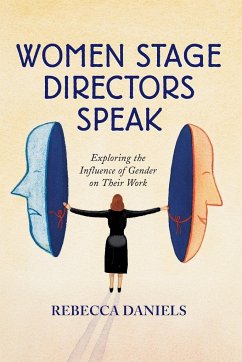- Broschiertes Buch
- Merkliste
- Auf die Merkliste
- Bewerten Bewerten
- Teilen
- Produkt teilen
- Produkterinnerung
- Produkterinnerung
Though stage directing has traditionally been a male-dominated profession, the number of women directors in the United States has grown significantly in recent years. In this work, 35 contemporary women stage directors, with regional, national and international theater backgrounds, share their views on the creative process and the influences of gender on their artistic decision making. How does it feel to be defined as a woman director rather than simply a director? Does gender affect their authority? These questions and many others are explored in this study.
Andere Kunden interessierten sich auch für
![Italian Horror Film Directors Italian Horror Film Directors]() Louis PaulItalian Horror Film Directors51,99 €
Louis PaulItalian Horror Film Directors51,99 €![Silent Stars Speak Silent Stars Speak]() Tony VilleccoSilent Stars Speak40,99 €
Tony VilleccoSilent Stars Speak40,99 €![Art Directors in Cinema Art Directors in Cinema]() Michael L. StephensArt Directors in Cinema65,99 €
Michael L. StephensArt Directors in Cinema65,99 €![Laura's Ghost: Women Speak about Twin Peaks Laura's Ghost: Women Speak about Twin Peaks]() Courtenay StallingsLaura's Ghost: Women Speak about Twin Peaks27,99 €
Courtenay StallingsLaura's Ghost: Women Speak about Twin Peaks27,99 €![Black Women Directors Black Women Directors]() Christina N BakerBlack Women Directors19,99 €
Christina N BakerBlack Women Directors19,99 €![Encyclopedia of Stage Lighting Encyclopedia of Stage Lighting]() Jody BriggsEncyclopedia of Stage Lighting63,99 €
Jody BriggsEncyclopedia of Stage Lighting63,99 €![A Moon for the Misbegotten on the American Stage A Moon for the Misbegotten on the American Stage]() Laura SheaA Moon for the Misbegotten on the American Stage40,99 €
Laura SheaA Moon for the Misbegotten on the American Stage40,99 €-
-
-
Though stage directing has traditionally been a male-dominated profession, the number of women directors in the United States has grown significantly in recent years. In this work, 35 contemporary women stage directors, with regional, national and international theater backgrounds, share their views on the creative process and the influences of gender on their artistic decision making. How does it feel to be defined as a woman director rather than simply a director? Does gender affect their authority? These questions and many others are explored in this study.
Hinweis: Dieser Artikel kann nur an eine deutsche Lieferadresse ausgeliefert werden.
Hinweis: Dieser Artikel kann nur an eine deutsche Lieferadresse ausgeliefert werden.
Produktdetails
- Produktdetails
- Verlag: McFarland
- Seitenzahl: 256
- Erscheinungstermin: 1. Juli 2000
- Englisch
- Abmessung: 229mm x 152mm x 15mm
- Gewicht: 421g
- ISBN-13: 9780786409655
- ISBN-10: 0786409657
- Artikelnr.: 22128378
- Herstellerkennzeichnung
- Libri GmbH
- Europaallee 1
- 36244 Bad Hersfeld
- gpsr@libri.de
- Verlag: McFarland
- Seitenzahl: 256
- Erscheinungstermin: 1. Juli 2000
- Englisch
- Abmessung: 229mm x 152mm x 15mm
- Gewicht: 421g
- ISBN-13: 9780786409655
- ISBN-10: 0786409657
- Artikelnr.: 22128378
- Herstellerkennzeichnung
- Libri GmbH
- Europaallee 1
- 36244 Bad Hersfeld
- gpsr@libri.de
Rebecca Daniels (MFA, PhD) taught performance, writing, and speaking in liberal arts universities for over twenty-five years, including St. Lawrence University in Canton, New York, from 1992-2015. She was the founding producing director of Artists Repertory Theatre in Portland, Oregon, directed with many professional Portland theater companies in the 1980s, and is the author of the groundbreaking Women Stage Directors Speak: Exploring the Effects of Gender on Their Work (McFarland, 1996, 2000) and has been published in multiple professional theater journals. After her retirement from teaching, she turned her focus to creative nonfiction and began her association with Sunbury Press with Keeping the Lights on for Ike: Daily Life of a Utilities Engineer at AFHQ in Europe During WWII; or, What to Say in Letters Home When You're Not Allowed to Write about the War (Sunbury Press, 2019), a book based on her father's letter home from Europe during WWII. Her second book with Sunbury, Finding Sisters: How One Adoptee Used DNA Testing and Determination to Uncover Family Secrets and Find Her Birth Family, explores how DNA testing, combined with traditional genealogical research, helped her find her genetic parents, two half-sisters, and other relatives in spite of being given up for a closed adoption at birth. Learn more at rebecca-daniels.com.
Table of Contents
ACKNOWLEDGMENTS
PREFACE
The Study, Its Significance, and the Methods Used
PART ONE -INTRODUCTION
1: A Brief History of the Directorial Function, Theories, and
Processes
Directing Theory
Qualities of a Good Director
Practical Elements of the Directing Process
Communication in Directing
A Director Plays Many Roles
2: The Women Interviewed and Their Perceptions of Gender Differences
A Brief Introduction to the Directors
Positions on Gender Differences
3: Gender Means Everything and Nothing
Resisting Definition as a Woman Director
Thinking About Gender When Working
Ignoring Gender
No Easy Answers
PART TWO-LEADERSHIP ISSUES FOR WOMEN DIRECTORS
4: Leadership Qualities in a Good Director
The Importance of Good Leadership
The Power of the Director
Reception of Women in Positions of Authority
5: Problems with Power
Resistance to Women in Authority
Issues of Behavior
Internal Resistance and Self-Doubt
PART THREE-COLLABORATION ISSUES FOR WOMEN DIRECTORS
6: Collaborative Qualities in a Good Director
The Importance of Successful Collaboration
Social Conditioning and Collaboration
A Different Approach to Collaboration
Possible Negatives in Collaboration
7: Women's Ways of Collaborating
Sensitivity to Feelings and Emotions
Creating an Environment of Trust and Intimacy
Nurturance
Use of Instinct and Intuition
Finding a Balance
PART FOUR-PRACTICAL ELEMENTS OF THE DIRECTING PROCESS
8: Issues in Script Selection and Interpretation
Factors in the Script Selection Process
Themes Related to Women and Gender
An Awareness of Women's Issues
Other Influences on Script Selection
Overcoming Perceived Limitations
9: Working with Actors
Casting Issues
Character Development Issues
10: Technical and Spatial Issues Influenced by Gender
Technical Considerations
Use of Space
11: Economic and Career Considerations
Family Demands
Career Development
CONCLUSION
APPENDIX A: SIGNIFICANT INFLUENCE ON THE DIRECTORS' ARTISTIC IDENTITY AND
PERSONAL DEVELOPMENT
APPENDIX B: THEATRICAL BIOGRAPHIES OF THE DIRECTORS
NOTES
BIBLIOGRAPHY
INDEX
ACKNOWLEDGMENTS
PREFACE
The Study, Its Significance, and the Methods Used
PART ONE -INTRODUCTION
1: A Brief History of the Directorial Function, Theories, and
Processes
Directing Theory
Qualities of a Good Director
Practical Elements of the Directing Process
Communication in Directing
A Director Plays Many Roles
2: The Women Interviewed and Their Perceptions of Gender Differences
A Brief Introduction to the Directors
Positions on Gender Differences
3: Gender Means Everything and Nothing
Resisting Definition as a Woman Director
Thinking About Gender When Working
Ignoring Gender
No Easy Answers
PART TWO-LEADERSHIP ISSUES FOR WOMEN DIRECTORS
4: Leadership Qualities in a Good Director
The Importance of Good Leadership
The Power of the Director
Reception of Women in Positions of Authority
5: Problems with Power
Resistance to Women in Authority
Issues of Behavior
Internal Resistance and Self-Doubt
PART THREE-COLLABORATION ISSUES FOR WOMEN DIRECTORS
6: Collaborative Qualities in a Good Director
The Importance of Successful Collaboration
Social Conditioning and Collaboration
A Different Approach to Collaboration
Possible Negatives in Collaboration
7: Women's Ways of Collaborating
Sensitivity to Feelings and Emotions
Creating an Environment of Trust and Intimacy
Nurturance
Use of Instinct and Intuition
Finding a Balance
PART FOUR-PRACTICAL ELEMENTS OF THE DIRECTING PROCESS
8: Issues in Script Selection and Interpretation
Factors in the Script Selection Process
Themes Related to Women and Gender
An Awareness of Women's Issues
Other Influences on Script Selection
Overcoming Perceived Limitations
9: Working with Actors
Casting Issues
Character Development Issues
10: Technical and Spatial Issues Influenced by Gender
Technical Considerations
Use of Space
11: Economic and Career Considerations
Family Demands
Career Development
CONCLUSION
APPENDIX A: SIGNIFICANT INFLUENCE ON THE DIRECTORS' ARTISTIC IDENTITY AND
PERSONAL DEVELOPMENT
APPENDIX B: THEATRICAL BIOGRAPHIES OF THE DIRECTORS
NOTES
BIBLIOGRAPHY
INDEX
Table of Contents
ACKNOWLEDGMENTS
PREFACE
The Study, Its Significance, and the Methods Used
PART ONE -INTRODUCTION
1: A Brief History of the Directorial Function, Theories, and
Processes
Directing Theory
Qualities of a Good Director
Practical Elements of the Directing Process
Communication in Directing
A Director Plays Many Roles
2: The Women Interviewed and Their Perceptions of Gender Differences
A Brief Introduction to the Directors
Positions on Gender Differences
3: Gender Means Everything and Nothing
Resisting Definition as a Woman Director
Thinking About Gender When Working
Ignoring Gender
No Easy Answers
PART TWO-LEADERSHIP ISSUES FOR WOMEN DIRECTORS
4: Leadership Qualities in a Good Director
The Importance of Good Leadership
The Power of the Director
Reception of Women in Positions of Authority
5: Problems with Power
Resistance to Women in Authority
Issues of Behavior
Internal Resistance and Self-Doubt
PART THREE-COLLABORATION ISSUES FOR WOMEN DIRECTORS
6: Collaborative Qualities in a Good Director
The Importance of Successful Collaboration
Social Conditioning and Collaboration
A Different Approach to Collaboration
Possible Negatives in Collaboration
7: Women's Ways of Collaborating
Sensitivity to Feelings and Emotions
Creating an Environment of Trust and Intimacy
Nurturance
Use of Instinct and Intuition
Finding a Balance
PART FOUR-PRACTICAL ELEMENTS OF THE DIRECTING PROCESS
8: Issues in Script Selection and Interpretation
Factors in the Script Selection Process
Themes Related to Women and Gender
An Awareness of Women's Issues
Other Influences on Script Selection
Overcoming Perceived Limitations
9: Working with Actors
Casting Issues
Character Development Issues
10: Technical and Spatial Issues Influenced by Gender
Technical Considerations
Use of Space
11: Economic and Career Considerations
Family Demands
Career Development
CONCLUSION
APPENDIX A: SIGNIFICANT INFLUENCE ON THE DIRECTORS' ARTISTIC IDENTITY AND
PERSONAL DEVELOPMENT
APPENDIX B: THEATRICAL BIOGRAPHIES OF THE DIRECTORS
NOTES
BIBLIOGRAPHY
INDEX
ACKNOWLEDGMENTS
PREFACE
The Study, Its Significance, and the Methods Used
PART ONE -INTRODUCTION
1: A Brief History of the Directorial Function, Theories, and
Processes
Directing Theory
Qualities of a Good Director
Practical Elements of the Directing Process
Communication in Directing
A Director Plays Many Roles
2: The Women Interviewed and Their Perceptions of Gender Differences
A Brief Introduction to the Directors
Positions on Gender Differences
3: Gender Means Everything and Nothing
Resisting Definition as a Woman Director
Thinking About Gender When Working
Ignoring Gender
No Easy Answers
PART TWO-LEADERSHIP ISSUES FOR WOMEN DIRECTORS
4: Leadership Qualities in a Good Director
The Importance of Good Leadership
The Power of the Director
Reception of Women in Positions of Authority
5: Problems with Power
Resistance to Women in Authority
Issues of Behavior
Internal Resistance and Self-Doubt
PART THREE-COLLABORATION ISSUES FOR WOMEN DIRECTORS
6: Collaborative Qualities in a Good Director
The Importance of Successful Collaboration
Social Conditioning and Collaboration
A Different Approach to Collaboration
Possible Negatives in Collaboration
7: Women's Ways of Collaborating
Sensitivity to Feelings and Emotions
Creating an Environment of Trust and Intimacy
Nurturance
Use of Instinct and Intuition
Finding a Balance
PART FOUR-PRACTICAL ELEMENTS OF THE DIRECTING PROCESS
8: Issues in Script Selection and Interpretation
Factors in the Script Selection Process
Themes Related to Women and Gender
An Awareness of Women's Issues
Other Influences on Script Selection
Overcoming Perceived Limitations
9: Working with Actors
Casting Issues
Character Development Issues
10: Technical and Spatial Issues Influenced by Gender
Technical Considerations
Use of Space
11: Economic and Career Considerations
Family Demands
Career Development
CONCLUSION
APPENDIX A: SIGNIFICANT INFLUENCE ON THE DIRECTORS' ARTISTIC IDENTITY AND
PERSONAL DEVELOPMENT
APPENDIX B: THEATRICAL BIOGRAPHIES OF THE DIRECTORS
NOTES
BIBLIOGRAPHY
INDEX








